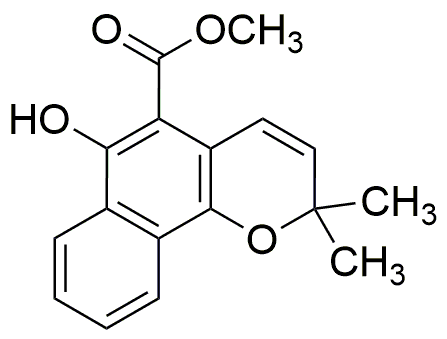Mollugin is widely utilized in research focused on:
- Pharmaceutical Development: Mollugin has demonstrated potential as an anti-cancer agent, particularly in inhibiting the growth of various cancer cell lines. This makes it a valuable compound for researchers developing new cancer therapies.
- Antioxidant Applications: Its antioxidant properties are beneficial in formulating dietary supplements and skincare products, helping to protect cells from oxidative stress and improve skin health.
- Natural Product Research: As a compound derived from natural sources, it is often studied for its bioactive properties, leading to the discovery of new natural products with therapeutic benefits.
- Food Industry: Mollugin can be explored as a natural preservative due to its antimicrobial properties, offering a safer alternative to synthetic preservatives in food products.
- Cosmetic Formulations: Its skin-soothing and anti-inflammatory effects make it a promising ingredient in cosmetics, particularly for products aimed at sensitive skin.
General Information
Properties
Safety and Regulations
Applications
Mollugin is widely utilized in research focused on:
- Pharmaceutical Development: Mollugin has demonstrated potential as an anti-cancer agent, particularly in inhibiting the growth of various cancer cell lines. This makes it a valuable compound for researchers developing new cancer therapies.
- Antioxidant Applications: Its antioxidant properties are beneficial in formulating dietary supplements and skincare products, helping to protect cells from oxidative stress and improve skin health.
- Natural Product Research: As a compound derived from natural sources, it is often studied for its bioactive properties, leading to the discovery of new natural products with therapeutic benefits.
- Food Industry: Mollugin can be explored as a natural preservative due to its antimicrobial properties, offering a safer alternative to synthetic preservatives in food products.
- Cosmetic Formulations: Its skin-soothing and anti-inflammatory effects make it a promising ingredient in cosmetics, particularly for products aimed at sensitive skin.
Documents
Safety Data Sheets (SDS)
The SDS provides comprehensive safety information on handling, storage, and disposal of the product.
Product Specification (PS)
The PS provides a comprehensive breakdown of the product’s properties, including chemical composition, physical state, purity, and storage requirements. It also details acceptable quality ranges and the product's intended applications.
Certificates of Analysis (COA)
Search for Certificates of Analysis (COA) by entering the products Lot Number. Lot and Batch Numbers can be found on a product’s label following the words ‘Lot’ or ‘Batch’.
*Catalog Number
*Lot Number
Certificates Of Origin (COO)
This COO confirms the country where the product was manufactured, and also details the materials and components used in it and whether it is derived from natural, synthetic, or other specific sources. This certificate may be required for customs, trade, and regulatory compliance.
*Catalog Number
*Lot Number
Safety Data Sheets (SDS)
The SDS provides comprehensive safety information on handling, storage, and disposal of the product.
DownloadProduct Specification (PS)
The PS provides a comprehensive breakdown of the product’s properties, including chemical composition, physical state, purity, and storage requirements. It also details acceptable quality ranges and the product's intended applications.
DownloadCertificates of Analysis (COA)
Search for Certificates of Analysis (COA) by entering the products Lot Number. Lot and Batch Numbers can be found on a product’s label following the words ‘Lot’ or ‘Batch’.
*Catalog Number
*Lot Number
Certificates Of Origin (COO)
This COO confirms the country where the product was manufactured, and also details the materials and components used in it and whether it is derived from natural, synthetic, or other specific sources. This certificate may be required for customs, trade, and regulatory compliance.


